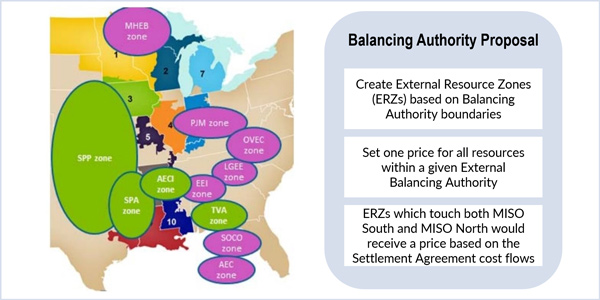By Amanda Durish Cook
FERC last week rejected MISO’s proposal to create external zones for its annual capacity auction but left the door open for the RTO to submit a revised version of the plan in the future.
Under the proposal, MISO would have altered its Planning Resource Auction to include external resource zones based on neighboring balancing authority areas. In cases of price separation, the RTO would also distribute historical supply arrangement credits from excess auction revenues as a refund to external resources with long-term and consistently used historical supply agreements.
The proposal also included two new external resource subcategories: border external resources and coordinating owner external resources, which would be modeled and priced according to the existing local resource zone with which the resource shared a direct electrical connection. MISO had said that both types of resources are comparable to its internal resources and can meet physical and operational criteria that allow them to continue to be treated as if they were inside a local resource zone. (See MISO Closing in on External Capacity Zones.)
The RTO had hoped to implement the new external zones by the 2019/20 planning year.
But in its Aug. 2 ruling, the commission took issue with two provisions of the proposal, both introduced in response to a deficiency letter in May (ER18-1173). (See FERC: MISO External Capacity Zone Plan Deficient.)
The first provision would have allowed an external resource bordering more than one local resource zone to choose which zone to participate in during the auction. The second would have permitted holders of evergreen contracts — supply contracts that include extension or renewal options written prior to MISO’s capacity construct — to receive historical supply arrangement credits collected from excess auction revenues to cover price separation. FERC said both provisions were unreasonable.
No Zone Toggle
FERC’s order said it was problematic for MISO to allow resource owners to toggle between zones in search of the best capacity prices.
“MISO’s proposal provides resource owners with new optionality that could lead to uneconomic behavior. For instance, a market participant could decide to move a lower cost capacity resource from one local zone to another in order to increase the likelihood that an affiliated higher-cost capacity resource clears in the local zone from which the capacity resource was moved. The ability to effectively move capacity resources from one local zone to another is not contemplated by the Tariff’s market power and mitigation provisions.”
MISO also proposed allowing internal capacity resources that border more than one local resource zone the option to choose their zone of participation, providing the “same flexibility” as similarly situated border external resources. The RTO said it contains 20 eligible internal resources and only one border external resource, the Joppa Power Plant in southern Illinois, with ties to multiple local zones.
But FERC said that rather than allowing market participants to select local zones, MISO could divide the resource’s capacity credit between the zones it borders using historic or forecasted system flows. The RTO could also propose a new system that determines how capacity credit is assigned to a resource that borders multiple local zones, the commission said.
Evergreen Contracts
FERC also determined that MISO should not make evergreen contract extensions eligible for excess auction revenues, saying the option would “embed inefficiencies into MISO’s resource adequacy construct for an indefinite period of time.”
“LSEs with evergreen contracts could continue to extend those contracts indefinitely to avoid the locational price signal that MISO’s locational resource adequacy construct was designed to provide,” the commission said.
Rejection in Full
FERC said it rejected the filing in full because MISO had instructed it to evaluate the contract as a cohesive whole. In its filing, MISO had said the elements “were created as a complete and balanced package based on discussions and adjustments made during the stakeholder process” and “are intended to be an integrated set of elements to improve MISO’s existing resource adequacy construct and should not be viewed in isolation.”
The RTO plans to discuss the proposal during an Aug. 8 Resource Adequacy Subcommittee meeting.





